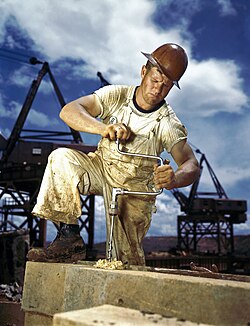 | |
| Company type | Public |
|---|---|
| NYSE: MSA S&P 400 Component | |
| Industry | Safety equipment |
| Founded | 1914 |
| Headquarters | Cranberry Township, Pennsylvania |
Key people | Steve Blanco, CEO |
| Products | SCBA Gas detector Hard hat Safety harness Respirator Thermal imaging camera |
| Revenue | |
Number of employees | 5,000 |
| Website | www |

Mine Safety Appliances, or MSA Safety Incorporated, is an American manufacturer and supplier of personal protective equipment (PPE) and other safety equipment designed for use in a variety of hazardous conditions in industries such as construction, the military, fire service, and chemical, oil, and gas production.[1][2] MSA is based in the Pittsburgh suburb of Cranberry. [1]
Contents
Best known for its Bakelite Skullgard hard hat, the company’s product line includes gas monitoring and detection instruments, filter-type respirators, gas masks, breathing apparatus used by firefighters, thermal imaging cameras, firefighter helmets, ballistic body armor, military communications systems, a broad range of industrial head and fall protection products, and safety products for Do-It-Yourself consumers. [2] [3]
MSA was founded in 1914 [1] after development of the Edison Safety Mining Lamp by mining engineer John T. Ryan Sr. and George H. Deike with help from Thomas Edison following a terrible mine explosion in West Virginia in 1912. [4] The mining lamp was a battery-powered headlamp for miners to help prevent methane-related explosions caused by open flame lamps. Since the turn of the 21st century, MSA has seen record sales. Only a small portion of the company's current products involve mining related products. The company’s competitors include Industrial Scientific Corporation, RAE Systems and Dräger. [5]
The corporation's assets are managed through two business segments: MSA North America and MSA International. MSA has sales and manufacturing operations throughout the world and sells products to customers in more than 140 countries. While the majority of MSA's products are available only through distributors, the company does sell head, eye, ear, respiratory and body protection products to individuals through a variety of hardware and home center retail outlets.